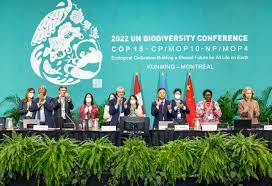
Kunming-Montreal Global Biodiversity Framework
Kunming-Montreal Global Biodiversity Framework
Important for Prelims
Kunming-Montreal Global Biodiversity Framework (KMGBF), Intergovernmental Science-Policy Platform on Biodiversity and Ecosystem Services (IPBES), COP-15, Bio -Convention on Diversity (CBD)
Important for Mains
Impact and relevance of the Kunming-Montreal Global Biodiversity Framework on the Environment and Nature Conservation
October 26, 2023
Why in News:
- Recently, key recommendations related to the Kunming-Montreal Global Biodiversity Framework were adopted at the 25th meeting of the Subsidiary Body on Scientific, Technical and Technological Advice (SBSTTA-25) in Nairobi, Kenya.
- These recommendations relate to biodiversity loss, climate change, ocean acidification, desertification, land degradation, invasive alien species and pollution crises.
Recommendations:
- To address these challenges coherently and effectively, the Group finalized 15 key points for presentation at the 16th Conference of the Parties (COP16) to the Convention on Biological Diversity (CBD).
- This approach aligns with the Convention, the Kunming-Montreal Global Biodiversity Framework and other global initiatives, such as the United Nations Framework Convention on Climate Change and the Sustainable Development Goals 2030.
- Additionally, the meeting stressed the importance of other multilateral agencies, including the World Health Organization and the Food and Agriculture Organization, to enhance scientific and technical guidance in implementing the “Kunming-Montreal Global Biodiversity Framework”.
Subsidiary Body on Scientific, Technical and Technological Advice (SBSTTA):
- Article 25 of the Convention on Biological Diversity establishes an intergovernmental scientific advisory body with no fixed term known as the Subsidiary Body on Scientific, Technical and Technological Advice (SBSTTA).
- Its purpose is to provide timely advice to the Conference of the Parties (COP) and its other subsidiary bodies regarding the implementation of the Convention.
Kunming-Montreal Global Biodiversity Framework (GBF)
About:
- It is a landmark agreement that was adopted as the Kunming-Montreal Global Biodiversity Framework (GBF) by the Parties to the United Nations Convention on Biological Diversity (CBD) at the 15th COP Conference on Biological Diversity (COP15) on 19 December 2022.
- COP15 was held under the chairmanship of China and hosting by Canada.
- The Framework, building on previous strategic plans, supports the achievement of the Sustainable Development Goals and sets an ambitious path to a world living in harmony with nature by 2050.
- GBF aims to address biodiversity loss, restore ecosystems and protect indigenous rights.
30x30 target:
- The concept of '30x30' target was introduced at COP15, which will achieve 30% of the conserved status of land and oceans on Earth by the year 2030. This concept involves preventing the loss of nature and preserving degraded ecosystems.
Main goals:
The framework includes four goals for the year 2050 and 23 goals for the year 2030.
The GBF includes four broad global goals to protect nature:
- Halting human-induced extinction of threatened species and reducing extinction rates for all species by tenfold by 2050;
- Sustainable use and management of biodiversity to ensure that nature's contribution to people is valued, maintained and enhanced;
- Fair sharing of the benefits arising from the use of genetic resources, and digital sequence information on genetic resources;
- And adequate means of implementing the GBF should be accessible to all parties, especially least developed countries and small island developing states.
The GBF also includes 23 targets to be achieved by 2030:
- To effectively conserve and manage at least 30 percent of the world's land, coastal areas and oceans.
- Currently, 17 percent of land and 8 percent of marine areas are under conservation.
- Restoring 30 percent of terrestrial and marine ecosystems.
- Reducing the loss of areas of high biodiversity importance and high ecological integrity to near zero.
- Halving global food waste.
- Phase out or reform subsidies that cause at least $500 billion per year in biodiversity loss, while increasing positive incentives for biodiversity conservation and sustainable use.
- Mobilize at least $200 billion per year from public and private sources for biodiversity-related financing.
- To increase international financial flows from developed to developing countries to at least US$ 30 billion per year.
- International companies and financial institutions are required to monitor, assess and transparently disclose risks and impacts on biodiversity through their operations, portfolios, supply and value chains.
Kunming Biodiversity Fund:
- China has supported the creation of a new US$233 million fund for biodiversity conservation in developing countries. Additionally, the United Nations' Global Environment Facility (GEF) already helps developing countries finance green projects.
Source-DT E
-----------------------------
Mains exam
Discuss the impact and relevance of the Kunming-Montreal Global Biodiversity Framework on environment and nature conservation.